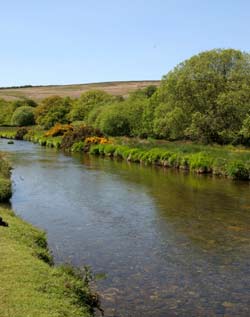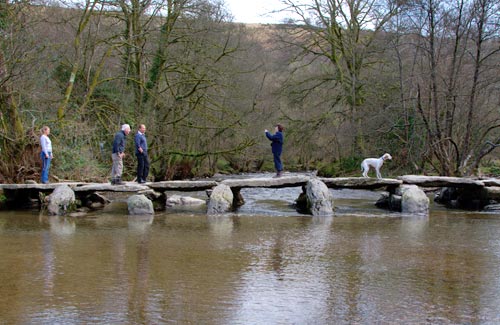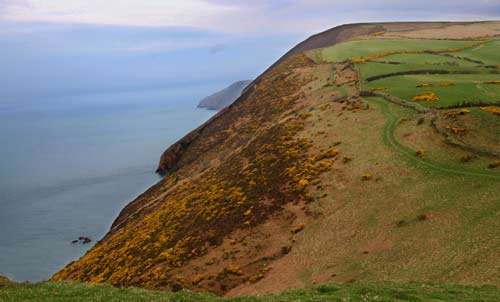![]()
Exmoor - Holiday Accommodation, Activities and Places of Interest
![]()
Holiday cottages on a small farm with lovely gardens and fantastic views.
Private Woodland - Gym - Short Breaks - Dogs welcome off peak.
Exmoor National Park is situated in the counties of Devon and Somerset in South West England; Exeter is 40 km (30 miles) to the south and Taunton 20 km (13 miles) from the eastern boundary. The park contains a variety of magnificent landscapes. Although it is one of the smaller National Parks (693 km², 267 sq. miles) the central plateau of open moorland is remote and spacious. To the north the moorland terminates in towering cliffs above the Bristol Channel. Rocky headlands, steep wooded ravines, plunging waterfalls and jumbled heaps of fallen rock make this an area of outstanding scenic beauty; it is defined as a Heritage Coast.

Inland, the grass moorland is surrounded
by heather-clad rounded hills
mostly over 300 m (900 ft). Dunkery Beacon is the highest
point on Exmoor 519 m (1704 ft). This high land catches clouds
from the Atlantic with rainfall up to 2000 mm (80 ins) a  year
and forms a catchment area for numerous rivers and streams which
flow rapidly to the north and more gently to the south. It is
not surprising that the moor is named after its main river, the
River Exe. The moorland is dissected by combes (steep wooded
valleys) formed by these fast-running streams.
year
and forms a catchment area for numerous rivers and streams which
flow rapidly to the north and more gently to the south. It is
not surprising that the moor is named after its main river, the
River Exe. The moorland is dissected by combes (steep wooded
valleys) formed by these fast-running streams.
To the east lie the cultivated Brendon Hills, heavily wooded
in the north but with enclosed fields surrounded by banks and
fine beech hedges to the south. This typical landscape extends
right across the south western lower slopes of the moor. Here
there is some dairying but Exmoor is farmed mainly with beef
cattle and sheep.
The moorland on Exmoor developed largely as a result of the destruction of woodland in prehistoric times. It spread during the Iron Age (about 2000 years ago), when the cool, wet climate created suitable conditions. On the gently undulating hills there are extensive areas of uncultivated moorland, an open treeless landscape on peaty soil. The heather moors are dominated by ling, with whortleberry, whose fruits are a local delicacy, and bracken creeping up on to them from the combes. In the centre of Exmoor around Simonsbath lies the former royal hunting forest; an area of extensive grass moorland formed from purple moor grass and deer sedge, with cotton grass and bog asphodel in the wet mires. The moorland on the coast, known as coastal heath, is the most colourful - bright pink-purple bell heather as well as ling contrasting with the vivid yellow western gorse.
One of the main
reasons why Exmoor was chosen as a National Park was the beauty
and variety of  its wild landscape. This includes:
its wild landscape. This includes:
Moorland
Woodland
Villages and farmland
River valleys (called combes),
Coast and cliffs.
Each type of landscape provides many different habitats for a huge number of animals, birds, insects and plants where on Exmoor there are:
Some 31 native mammals, including the red deer and the Exmoor pony - rare wild moorland ponies, Britain's oldest breed.
Over 243 different species of bird
Over 100 species of nesting birds, including snipe, curlew, whinchat and merlin
Over 1000 flowers and grasses have been recorded including include pale butterwort, ivy-leaved bellflower and lesser twayblade.
1751 species of insects identified. These include 254 species of bugs, 80 different ants, bees and wasps, 262 beetles and over a 1000 moths
 But it isn't just the number of species
that makes Exmoor's wildlife so special. There are many unusual
habitats on Exmoor which have not been disturbed, where uncommon,
and even rare, plants and animals live. Some of the habitats
are so unusual that they have been made Sites of Special Scientific
Interest (SS SI or 'Triple
S I' for short).
But it isn't just the number of species
that makes Exmoor's wildlife so special. There are many unusual
habitats on Exmoor which have not been disturbed, where uncommon,
and even rare, plants and animals live. Some of the habitats
are so unusual that they have been made Sites of Special Scientific
Interest (SS SI or 'Triple
S I' for short).
Visitor centres are conveniently located for visitors to the National Park at Combe Martin, County Gate, Lynmouth, Dunster, and Dulverton. Each has displays related to the locality and a variety of information is available. A programme of National Park Authority events incorporating guided walks is offered throughout the year - the monthly events and walks list is freely available
Worth a Visit - Snowdrop Valley
Photography - Kate Price
Activities, Self Catering, Bed and Breakfast, Hotels, Campsites & Parks, Places to Eat, Attractions, More Places of Interest
Listings on the Devon Holiday Directory
![]()